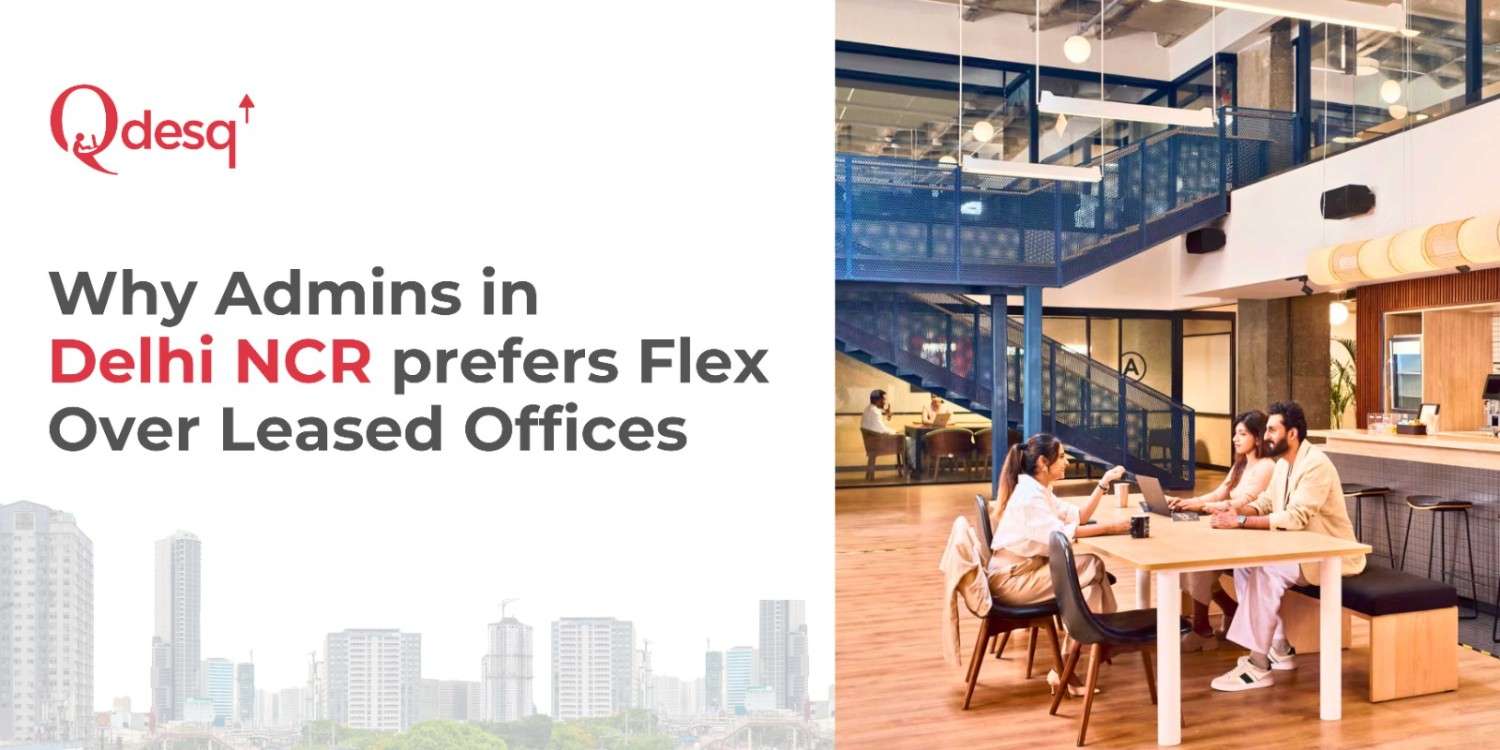I. Introduction: Why Admin Heads Are Ditching Traditional Leases
In today’s fast-moving business world, companies are rethinking their workspace goals. They want to meet the needs of the modern workforce. The old lease model is under pressure from more practical options. Instead, Admin Heads and Facility Managers are turning toward flexible, employee-friendly spaces that improve productivity without locking the company into lengthy contracts.
A smarter and more convenient choice is flexible office space in Delhi NCR. Managed offices and coworking spaces are ready to use, fully furnished, and backed by professional administration. These setups allow businesses to scale up or down as needed, saving time and operational effort. In areas like Noida and Gurgaon, the demand for such spaces is growing fast.
This blog explores why more Admin Heads are choosing flexible office solutions over traditional leases. It highlights how flex spaces solve common leasing challenges like high overhead costs, limited scalability, and a lack of modern amenities. If you’re looking for a smart alternative that supports growth and efficiency, flexible offices might be your best bet.
II. The Traditional Lease Burden: A Hidden Operational Trap
Conventional leasing appears to be a secure method. Nevertheless, it bothers the busy, present-day companies and ensnares them more regularly than it helps. These leases are exposing Admin Heads in the Delhi NCR region to a lot of surprises. Such issues may consume resources, time and energy. Here’s how:
A. High Upfront Costs (CAPEX Pain)
Hefty initial charges characterise classical leases. These are security deposits, expensive fit-outs and infrastructure setup. These costs are incurred at a time when businesses must have flexibility and the least risk possible. This outflow of capital may disturb the strategic preferences, particularly to growing teams. Choosing an affordable office in India cuts costs and gives you quick access to infrastructure.
B. Unpredictable Running Costs (OPEX Volatility)
Recurring expenses like maintenance, utilities, property taxes, and labour costs can be unpredictable. They might rise suddenly and without warning. These expenses cause ongoing budgeting issues and make financial planning harder. Admin Heads are left to struggle with these swings rather than focus on core business requirements. It is one of the biggest issues with traditional leases. This problem makes the model costly for efficiency-focused businesses.
C. Scalability Challenges
Expansion requires elasticity. Conventional leases can trap companies. They must deal with rigid contracts and long lock-in periods. Want to expand? It takes a long and complicated process. Downsizing? It is even more difficult. An agile or hybrid team structure often receives limited attention. This inflexibility stops scaling. So, teams must work around limits instead of growing with business needs.
D. Time Drain & Vendor Chaos
Managing multiple vendors for cleaning, repairs, compliance, and payments is a daily hassle. Admin teams spend too much time fixing operational issues. This takes away from their ability to support HR, employee wellness, and company culture. Inefficiencies directly affect admin and business productivity. Major leases no longer fit today’s businesses, and Admin Heads are noticing.
III. The Rise of Hassle-Free Flex Spaces: A Strategic Revolution
Delhi NCR is evolving, and its business needs are changing accordingly. Admin Heads are leading a shift to managed offices. This change offers a smart, stress-free option. It balances flexibility, cost control, and operational simplicity. This is how the flexible office space in Delhi NCR is the future of business:
A. Cost Efficiency & Budget Predictability
Flex spaces eliminate capital expenditure (CAPEX) associated with plug-and-play systems. It does not require any fit-out or infrastructure investment. Rather, firms enjoy inclusive monthly charges that make budgeting easier. Up to 40 per cent savings in office space are available in India, mostly in such business centres as Gurgaon and Noida. Alignment with CFOs and simple assignment of resources are also easier in this model.
B. Scalability & Flexibility
Scalability is one of the greatest merits of coworking spaces such as Coworking Noida. Flexible office spaces enable short-term transformations of space, whether for expansions, reductions, or the start of a project team, department development, or hybrid working models. Depending on the real-time requirements, desks, small cabins or meeting rooms could be delegated/allocated.
With short-term leases, modular arrangements, and incurring no relocation costs, business enterprises will no longer need to worry about being locked into space that is not being optimally utilised. This is a significant victory for Admin Heads who are required to work with changing teams and priorities. It is an intelligent alternative for companies seeking flexibility in the number of offices they occupy, without being tied down to strict contracts.
C. Operational Freedom for Admin Heads
Admin Heads get high-value operational efficiency. There is only one touchpoint of the IT, housekeeping, pantry, security, and AV currently. There will be no more juggling of vendors or the time-consuming element of daily maintenance. The efficiency of the administrative model is increased. It helps groups prioritise their tasks. They can handle individuals, drive health programs and develop a pleasant workplace arrangement.
D. Premium Amenities & Brand Elevation
In Delhi NCR, and even more so in the future, work is no longer associated with fixed desks. Companies currently require vibrant places that can do more than provide seats. Designer offices have excellent meeting rooms, healthy facilities, breakout rooms, and high-tech capabilities. They also offer prestigious business addresses with the benefit of branding image, without the risk of long-term lock-ins.
All these advantages not only make companies attract and retain the best talents but also minimise operational overheads. Flex spaces offer a modern-day working environment that enables you to run a client meeting, provide remote team members, and create a collaborative workspace
E. Enhanced Employee Experience
Coworking spaces and flex spaces are both modern spaces that aim not only to offer a workplace but also contribute to the well-being of the employees and their cooperation. Equipped with ergonomically-made furniture, recreational areas, and frequent social gatherings, such settings may help to increase morale and limit burnout.
Coworking spaces also present an identity and national pride, as cultural events are celebrated, and there are no exclusive communities. This positive environment enhances the team spirit and develops the efficiency of different departments. Productivity is an inevitable natural result of insight into such mindful design with the freedom of hybrid work.
IV. Delhi NCR’s Flex Boom: Trends, Numbers, and Micro-Market Insights
Delhi NCR is fast becoming the epicentre of the flex space revolution in India. More companies desire to become versatile and economical. Consequently, the market of flex space ecosystems is expanding rapidly. This shift will prompt firms to reconsider how they use office space.
A. Delhi NCR’s Leading Role in India’s Flex Growth
The emerging real estate trends in India have revealed a 48 per cent increase in the flexible office market in 2025. Flex space providers were at the forefront of the race to win 7.4 million sq. ft. of the total office leasing in Delhi NCR with an approximate of 35-40 percent. The growth indicates a large change in office patterns and more flexible options. These will be managed offices in Gurgaon and coworking space in Noida. This transformation is due to a large number of industries, robust tech talent and a mix of employees in Delhi NCR.
B. Who’s Choosing Flex Spaces?
Flex spaces are no longer just for startups. MNCs, global capability centres (GCCs), mid-sized firms, and traditional companies are adopting this model in 2025. The tech industry accounts for over half of the demand for flex space. This shows that flex arrangements support development, innovation, and talent retention.
C. Micro-Market Overview
- Gurgaon: With their offices to die for, GCCs, consulting companies, and tech giants are thronging to Gurgaon. In this case, they are connected 24/7, and they have a quality infrastructure. They also connect with world-class businesses.
- Noida: A low-cost option to expand is Noida, which is already emerging as a coworking hotspot. It is among the fastest-developing spheres of startups. It is an ideal place where teams and creative companies flourish, thanks to the development of Film City.
- Delhi Core: Key areas like Aerocity and Nehru Place are popular for CXO suites, government offices, and corporate establishments. These regions are ideal for companies looking to take action.
D. Real Admin Voices (Conceptual Testimonials)
Our teams have been flexible in the use of flex spaces, which have enabled us to make strategic use of them. We are not prisoners in our daily routine.
We can now price our leases. No shocks and surprises in the form of additional expenses at the end of the month.”
We can now offer Silicon Valley-type perks and low overhead- what business won’t be impressed by this? Employees will love it as well.
Flex space is not only a new office address in Delhi NCR. It is the portrayal of a bright future in which firms can engage in operations, develop, and succeed in response to current needs.
V. From Cost Centre to Strategic Ally: The Admin Head Advantage
Admin Heads are becoming key professionals in Delhi NCR. They go beyond facility management. Now, they shape strategies. Their decisions impact workplace growth, culture, and team satisfaction.
Elevated Role
Admin Heads play the role of strategic planners as they wisely use their property. They are not merely reactive; they are proactive in case of flexible office spaces. They align with the business orientation within working environments.
Risk Reduction
High lock-ins and stranded space characterise conventional leases. The freedoms gained through flex spaces are the ability to scale up or down without penalty. Both increase the efficiency of operations and lessen financial risk.
Talent Magnet
Workstations can be improved with relaxation zones, proper equipment, and rest corners. These features enhance employees’ work-life balance. Give people a flexible office, and happier teams lead to reduced attrition, which is a major determinant of talent retention.
Brand Credibility
Modern offices in the best locations, designed effectively, are also professional. This instils confidence in the client and reinforces the company’s strong image in the market.
Compliance Offload
Admin teams are no longer required to deal with vendors, nor are they concerned with safety, legal, and maintenance problems. Flex invests in all the necessary elements to increase admin efficiency and allocate time for strategic consideration.
Managed workspaces will change admin Heads’ roles. They will shift from cost managers to strategic partners. This change is vital for creating agile, efficient, and future-ready organisations.
VI. Conclusion: A No-Brainer for Smart Admins in 2025
As the business environment changes rapidly, organisations reconsider their workspace setups. They seek to support the dynamic workforce better. Smart, simple, and flexible solutions are replacing traditional leases that once ruled the market. Admin Heads and Facility Managers lead this change. They favor flexible, employee-focused spaces that enhance productivity and streamline operations.
A great example is Ofis Square. They offer managed office spaces in Delhi NCR. These spaces offer flexibility, convenience, and quality infrastructure. You don’t have to manage everything by yourself.
By 2025, the workplace will be determined not only by location but also by business agility and staff requirements. You can use trusted providers like Ofis Square for quality infrastructure, modern facilities, and helpful management. This way, you avoid the hassle of daily operations.
Admin Heads who want efficiency, retention, and scalability don’t see flex spaces as a choice: they see the obvious solution.










